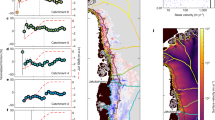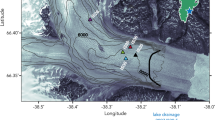Abstract
Increased ice velocities in Greenland1 are contributing significantly to eustatic sea level rise. Faster ice flow has been associated with ice–ocean interactions in water-terminating outlet glaciers2 and with increased surface meltwater supply to the ice-sheet bed inland. Observed correlations between surface melt and ice acceleration2,3,4,5,6 have raised the possibility of a positive feedback in which surface melting and accelerated dynamic thinning reinforce one another7, suggesting that overall warming could lead to accelerated mass loss. Here I show that it is not simply mean surface melt4 but an increase in water input variability8 that drives faster ice flow. Glacier sliding responds to melt indirectly through changes in basal water pressure9,10,11, with observations showing that water under glaciers drains through channels at low pressure or through interconnected cavities at high pressure12,13,14,15. Using a model that captures the dynamic switching12 between channel and cavity drainage modes, I show that channelization and glacier deceleration rather than acceleration occur above a critical rate of water flow. Higher rates of steady water supply can therefore suppress rather than enhance dynamic thinning16, indicating that the melt/dynamic thinning feedback is not universally operational. Short-term increases in water input are, however, accommodated by the drainage system through temporary spikes in water pressure. It is these spikes that lead to ice acceleration, which is therefore driven by strong diurnal melt cycles4,14 and an increase in rain and surface lake drainage events8,17,18 rather than an increase in mean melt supply3,4.
This is a preview of subscription content, access via your institution
Access options
Subscribe to this journal
Receive 51 print issues and online access
$199.00 per year
only $3.90 per issue
Buy this article
- Purchase on SpringerLink
- Instant access to full article PDF
Prices may be subject to local taxes which are calculated during checkout




Similar content being viewed by others
References
Rignot, E. & Kanagaratnam, P. Changes in the velocity structure of the Greenland ice sheet. Science 311, 986–990 (2006)
Joughin, I. et al. Seasonal speedup along the western flank of the Greenland ice sheet. Science 320, 781–783 (2008)
Zwally, H. J. et al. Surface-melt induced acceleration of Greenland ice-sheet flow. Science 5579, 218–222 (2002)
van de Wal, R. S. W. et al. Large and rapid melt-induced velocity changes in the ablation zone of the Greenland ice sheet. Science 321, 111–113 (2008)
Shepherd, A. et al. Greenland ice sheet motion coupled with daily melting in late summer. Geophys. Res. Lett. 36, L01501 (2009)
Bartholomew, I. et al. Seasonal evolution of subglacial drainage and acceleration in a Greenland outlet glacier. Nature Geosci. 3, 408–411 (2010)
Parizek, B. R. & Alley, R. B. Implications of increased Greenland surface melt under global-warming scenarios: ice-sheet simulations. Quat. Sci. Rev. 23, 1013–1027 (2004)
Bartholomaus, T. C., Anderson, R. S. & Anderson, S. P. Response of glacier basal motion to transient water storage. Nature Geosci. 1, 33–37 (2008)
Iken, A. & Bindschadler, R. A. Combined measurements of subglacial water pressure and surface velocity of Findelengletscher, Switzerland: conclusions about drainage system and sliding mechanism. J. Glaciol. 32, 101–119 (1986)
Iverson, N. R., Baker, R. W. & Hooke, R. LeB., Hanson, B. & Jansson, P. Coupling between a glacier and a soft bed: I. A relation between effective pressure and local shear stress determined from till elasticity. J. Glaciol. 45, 31–40 (1999)
Schoof, C. The effect of cavitation on glacier sliding. Proc. R. Soc. Lond. A 461, 609–627 (2005)
Kamb, B. et al. Glacier surge mechanism: 1982–1983 surge of Variegated Glacier, Alaska. Science 227, 469–479 (1985)
Iken, A., Echelmeyer, K. A., Harrison, W. D. & Funk, M. Mechanisms of fast flow in Jakobshavns Isbrae, Greenland, part I: measurements of temperature and water level in deep boreholes. J. Glaciol. 39, 15–25 (1993)
Hubbard, B., Sharp, M. J., Willis, I. C., Nielsen, M. K. & Smart, C. C. Borehole water-level variations and the structure of the subglacial hydrological system of Haut Glacier d’Arolla, Valais, Switzerland. J. Glaciol. 41, 572–583 (1995)
Lappegard, G., Kohler, J., Jackson, M. & Hagen, J. O. Characteristics of subglacial drainage system deduced from load-cell measurements. J. Glaciol. 52, 137–147 (2006)
Magnusson, E., Björnsson, H., Rott, H. & Palsson, F. Reduced glacier sliding caused by persistent drainage from a subglacial lake. Cryosphere 4, 13–20 (2010)
Howat, I. M., Tulaczyk, S., Waddington, E. & Björnsson, H. Dynamic controls on glacier basal motion inferred from surface ice motion. J. Geophys. Res. 113, F03015 (2008)
Das, S. B. et al. Fracture propagation to the base of the Greenland ice sheet during supraglacial lake drainage. Science 320, 778–781 (2008)
Röthlisberger, H. Water pressure in intra- and subglacial channels. J. Glaciol. 11, 177–203 (1972)
Nye, J. F. Water flow in glaciers: jökulhlaups, tunnels and veins. J. Glaciol. 17, 181–207 (1976)
Walder, J. Hydraulics of subglacial cavities. J. Glaciol. 32, 439–445 (1986)
Kamb, B. Glacier surge mechanism based on linked cavity configuration of the basal water conduit system. J. Geophys. Res. 92, 9083–9100 (1987)
Fowler, A. C. Sliding with cavity formation. J. Glaciol. 33, 255–267 (1987)
Lüthi, M., Funk, M., Iken, A., Gogineni, S. & Truffer, M. Mechanisms of fast flow in Jakobshavns Isbrae, Greenland, part III: measurements of ice deformation, temperature and cross-borehole conductivity in boreholes to the bedrock. J. Glaciol. 48, 369–385 (2002)
Hewitt, I. J. & Fowler, A. C. Seasonal waves on glaciers. Hydrol. Process. 22, 3919–3930 (2008)
Clarke, G. K. C. Lumped-element analysis of subglacial hydraulic circuits. J. Geophys. Res. 101, 17547–17559 (1996)
Hewitt, I. J. & Fowler, A. C. Melt channelization in ascending mantle. J. Geophys. Res. 114, B06210 (2009)
Schuenemann, K. C. & Cassano, J. J. Changes in synoptic weather patterns and Greenland precipitation in the 20th and 21st centuries: 2. Analysis of 21st century atmospheric changes using self-organizing maps. J. Geophys. Res. 115, D05108 (2010)
Tarasov, L. & Peltier, W. R. Terminating the 100 kyr ice age cycle. J. Geophys. Res. 102, 21665–21693 (1997)
Tsai, V. C. & Rice, J. R. A model for turbulent hydraulic fracture and application to crack propagation at glacier beds. J. Geophys. Res. 115, F03007 (2010)
Acknowledgements
Thanks to G. Clarke, T. Creyts, G. Flowers, I. Hewitt, R. Hindmarsh, M. Jellinek and V. Radić for comments on the manuscript, and to C. Koziol and M. Jaffrey for discussions. Financial support was provided by the Canada Research Chairs Program, NSERC Discovery Grant 357193-08 and the Canadian Foundation for Climate and Atmospheric Science through the Polar Climate Stability Network.
Author information
Authors and Affiliations
Corresponding author
Ethics declarations
Competing interests
The author declares no competing financial interests.
Supplementary information
Supplementary Information
This file contains Supplementary information and Data, supplementary Figures 1-12 with legends and additional references. (PDF 1861 kb)
Supplementary Movie 1
Formation of a subglacial drainage net - Spontaneous formation of a drainage network at melt input rate m = 10 cm day^(-1), remaining parameter values given in Supplementary Information. Panel a) shows conduit size, panel b) shows effective pressure distribution, panel c) shows mean effective pressure against time, with red dot indicating current time. (MPG 2433 kb)
Supplementary Movie 2
Drainage realignment (1) - Realignment of drainage system from a steady state with melt input rate m = 10 cm day^(-1), changed to reduced melt input m = .66 cm day^(-1). Remaining parameter values given in Supplementary Information. Panel a) shows conduit size, panel b) shows effective pressure distribution, panel c) shows mean effective pressure against time, with red dot indicating current time. (MPG 2617 kb)
Supplementary Movie 3
Drainage realignment (2) - Realignment of drainage system from a steady state with melt input rate m = 10 cm day^(-1), changed to reduced melt input m = 1 cm day^(-1). Remaining parameter values given in Supplementary Information. Panel a) shows conduit size, panel b) shows effective pressure distribution, panel c) shows mean effective pressure against time, with red dot indicating current time. (MPG 4688 kb)
Supplementary Movie 4
Oscillatory water input (1) - Response of drainage system to variable water input, starting with steady state with melt input rate m = 10 cm day^(-1). Remaining parameter values given in Supplementary Information. Panel a) shows conduit size, panel b) shows effective pressure distribution. Black line in panel c) shows mean effective pressure against time, with red dot indicating current time, blue line shows rate of water supply. (MPG 1423 kb)
Supplementary Movie 5
Oscillatory water input (2) - Response of drainage system to variable water input, starting with steady state with melt input rate m = 10 cm day^(-1). Remaining parameter values given in Supplementary Information. Panel a) shows conduit size, panel b) shows effective pressure distribution. Black line in panel c) shows mean effective pressure against time, with red dot indicating current time, blue line shows rate of melt supply. (MPG 872 kb)
Supplementary Movie 6
Localized water input - Response of drainage system to variable water input, starting with steady state with melt input rate m = 10 cm day^(-1). Remaining parameter values given in Supplementary Information. Panel a) shows conduit size, panel b) shows effective pressure distribution. Red dots indicate location of water input events. Water input is locally raised to 50 times the background rate, mimicking for instance a lake drainage event. (MPG 581 kb)
Supplementary Movie 7
Seasonal cycle - Response of drainage system to seasonal cycle. Remaining parameter values given in supplementary information. Panel a shows conduit size, panel b shows effective pressure distribution. Black line in panel c shows mean effective pressure against time, with red dot indicating current time, blue line shows rate of water supply. (MPG 1413 kb)
Rights and permissions
About this article
Cite this article
Schoof, C. Ice-sheet acceleration driven by melt supply variability. Nature 468, 803–806 (2010). https://doi.org/10.1038/nature09618
Received:
Accepted:
Published:
Issue Date:
DOI: https://doi.org/10.1038/nature09618
This article is cited by
-
Tidewater-glacier response to supraglacial lake drainage
Nature Communications (2022)
-
Threshold response to melt drives large-scale bed weakening in Greenland
Nature (2022)
-
The seasonal evolution of subglacial drainage pathways beneath a soft-bedded glacier
Communications Earth & Environment (2022)
-
Trapped meltwater affects mass loss of Greenland ice sheet
Nature (2022)
-
Antarctic basal environment shaped by high-pressure flow through a subglacial river system
Nature Geoscience (2022)




